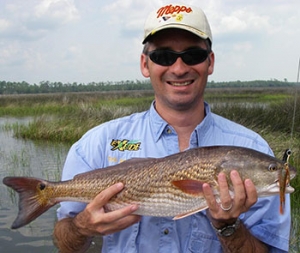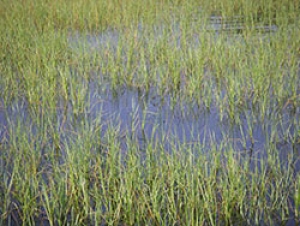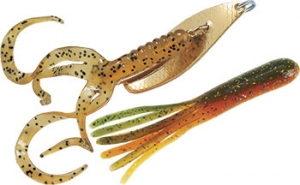by Captain Bob Morris
 Saltwater fishermen are well aware that spoons are excellent producers when it comes to redfish but the wide variety of makes and models can become confusing at times. Although spoons are all fairly similar, savvy anglers can appreciate how the subtle design differences can lead to success when trying to trigger a strike from the often fickle red drum.
Saltwater fishermen are well aware that spoons are excellent producers when it comes to redfish but the wide variety of makes and models can become confusing at times. Although spoons are all fairly similar, savvy anglers can appreciate how the subtle design differences can lead to success when trying to trigger a strike from the often fickle red drum.
Open water applications find that most spoons are created equal, but when it comes to fishing heavy cover the Mepps Timber Doodle stands above the rest for a variety of reasons.
In my home waters of the St. John's River, redfish can be easily patterned in two primary structure types - flooded spartina grass and submerged oyster beds. Although this heavy cover holds fish, it can be very difficult to present lures in either of these habitats.
 During the highest stages of the tide, redfish can be caught as they move into the spartina grass beds in search of small baitfish, shrimp, and fiddler crabs. These fish are on the feed, but it is difficult to target them with conventional lures or live bait due to the thick cover. The Timber Doodle shines in these conditions because of its truly weedless design - the bayonet keeper paired with the Mister Twister Split Double Tail trailer allows you to hide the hook point which lets the spoon pass through the thickest grass without snagging.
During the highest stages of the tide, redfish can be caught as they move into the spartina grass beds in search of small baitfish, shrimp, and fiddler crabs. These fish are on the feed, but it is difficult to target them with conventional lures or live bait due to the thick cover. The Timber Doodle shines in these conditions because of its truly weedless design - the bayonet keeper paired with the Mister Twister Split Double Tail trailer allows you to hide the hook point which lets the spoon pass through the thickest grass without snagging.
I prefer to cast a 1/2 oz. Timber Doodle far back into the heaviest grass and slowly work it into areas where there are "potholes" or breaks in the grass which serve as ambush points for the redfish. When the spoon hits the hole, give it a couple of jerks to emit flash and vibration and hold on! While redfish are primarily found inside the grass beds, speckled trout and flounder often lay along the outer edge in deeper water - as the spoon hits the open water let it flutter down and jig it a couple of times for the best results.
I also suggest experimenting with a Mister Twister Fat Tube as your trailer. The colors available in the Fat Tube will help you "match the hatch." I have enjoyed tremendous success with the fire tiger's orange pattern which mimics a fiddler crab's claw. Fat Tubes can be found on Mister Twister web site, www.mistertwister.com.
 Oyster reefs offer numerous snags that frustrate even the most experienced lure angler. Almost any sinking bait will somehow find a way to get wedged into one of the nooks and crannies when working the shells. Of course, you need to be right down in them because that is where the hungry reds are rooting around for shrimp, crabs, and small minnows. Here is where the Timber Doodle's unique shape and design becomes a real asset. Since the spoon does not have a tendency to turn over like others on the market, the hook always rides up and will not get hung on the bottom. Additionally, the spoon's shape is such that the Timber Doodle will ride-up and go over snags instead of settling down and getting stuck.
Oyster reefs offer numerous snags that frustrate even the most experienced lure angler. Almost any sinking bait will somehow find a way to get wedged into one of the nooks and crannies when working the shells. Of course, you need to be right down in them because that is where the hungry reds are rooting around for shrimp, crabs, and small minnows. Here is where the Timber Doodle's unique shape and design becomes a real asset. Since the spoon does not have a tendency to turn over like others on the market, the hook always rides up and will not get hung on the bottom. Additionally, the spoon's shape is such that the Timber Doodle will ride-up and go over snags instead of settling down and getting stuck.
In this environment I suggest slow rolling the spoon over the oysters with your rod tip held high. You should feel the spoon nicking the top of the shells but it will not get hung. When fishing this heavy cover it is important to beef up your tackle so you can muscle the fish out of the structure - 20lb line and leader should do the job effectively on these hard charging redfish.
In my travels, I have found the Timber Doodle to be equally effective in the hydrilla grass of the Louisiana Delta, the manatee grass of the Mosquito Lagoon in Florida, and the turtle grass of the Florida Keys using the same techniques described above. I suggest everyone who wants to target the heaviest cover when fishing for reds give this spoon a try.